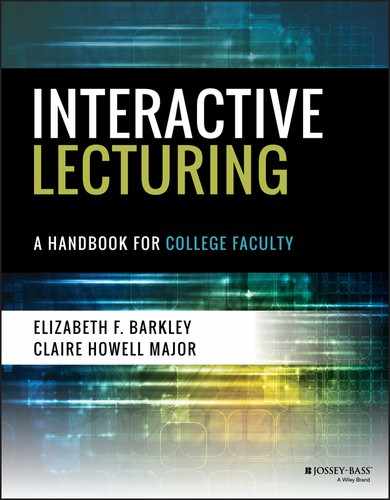ENGAGING LECTURE TIP 27
Out Loud
Most lecturers who are considered great at their craft have earned their distinction by hard work and perseverance. They know that it takes time and energy to create a memorable lecture and then careful, concentrated practice to do it well. As a college instructor, you have many responsibilities, and you will not likely have the time and energy to invest this kind of effort in every lecture. However, for those lectures that are particularly important or challenging, we recommend that you practice it Out Loud and in real time.
Practicing enables you to polish and refine your work. Your ideas will likely sound different in your head than they do out loud, so practicing gives you a chance to revise and refine. Out Loud also enables you to be more confident, which usually results in a better delivery. Moreover, this Tip can help you gauge how much time the presentation you have planned will actually take, which can help you to ensure that you have the appropriate amount of material for the class session as well as improve the timing and pacing of the session.
After you have planned your lecture, practice it aloud. If you have slides, work through the slide deck from start to finish. In your practice(s), aim for the following:
- Focus on the content to discover any problems with your language or flow, locate any missing transitions between ideas, and identify any information you need to add or remove.
- Consider your timing and pacing. Time the practice run to ensure that the lecture fills the time you have allocated for it (see Tip 12: Lecture Plan). Check your overall rate of speech and think about whether it feels too fast or too slow.
- Try audio or video recording this practice because doing so will make you more aware of any undesirable habits. For example, you may find that you need to eliminate waste words (uh, um, like). Alternately, you may find that you fidget or pace while talking and thus you can try to reduce these behaviors.
If you have the opportunity, do a trial run in the space in which you will give the lecture, particularly for the first lecture of a course. This step will help you to figure out details such as where you have to look to see slides, how you can move around the room comfortably, and where and how students will be seated.
Example
Key References and Resources
- Ford, N., McCullough, M., & Schutta, N. T. (2012). Presentation patterns: Techniques for crafting better presentations. Boston, MA: Addison Wesley.
- University of Waterloo. (n.d.). Lecturing effectively. Centre for Teaching Excellence. Retrieved from https://uwaterloo.ca/centre-for-teaching-excellence/teaching-resources/teaching-tips/lecturing-and-presenting/delivery/lecturing-effectively-university
